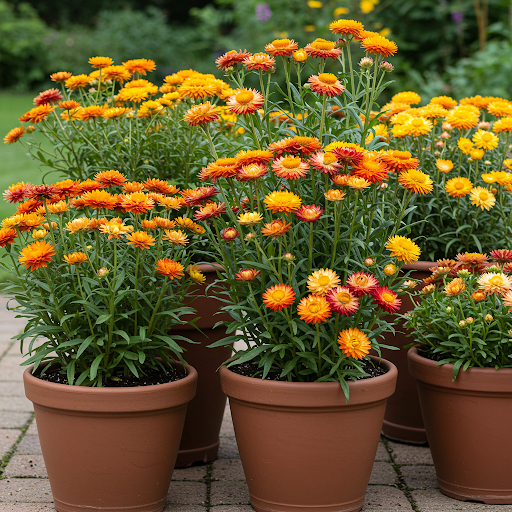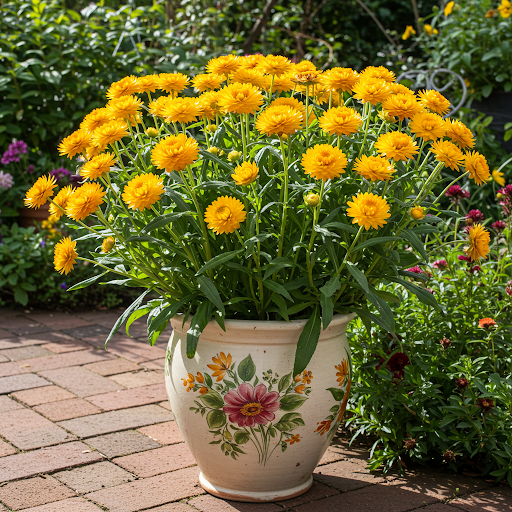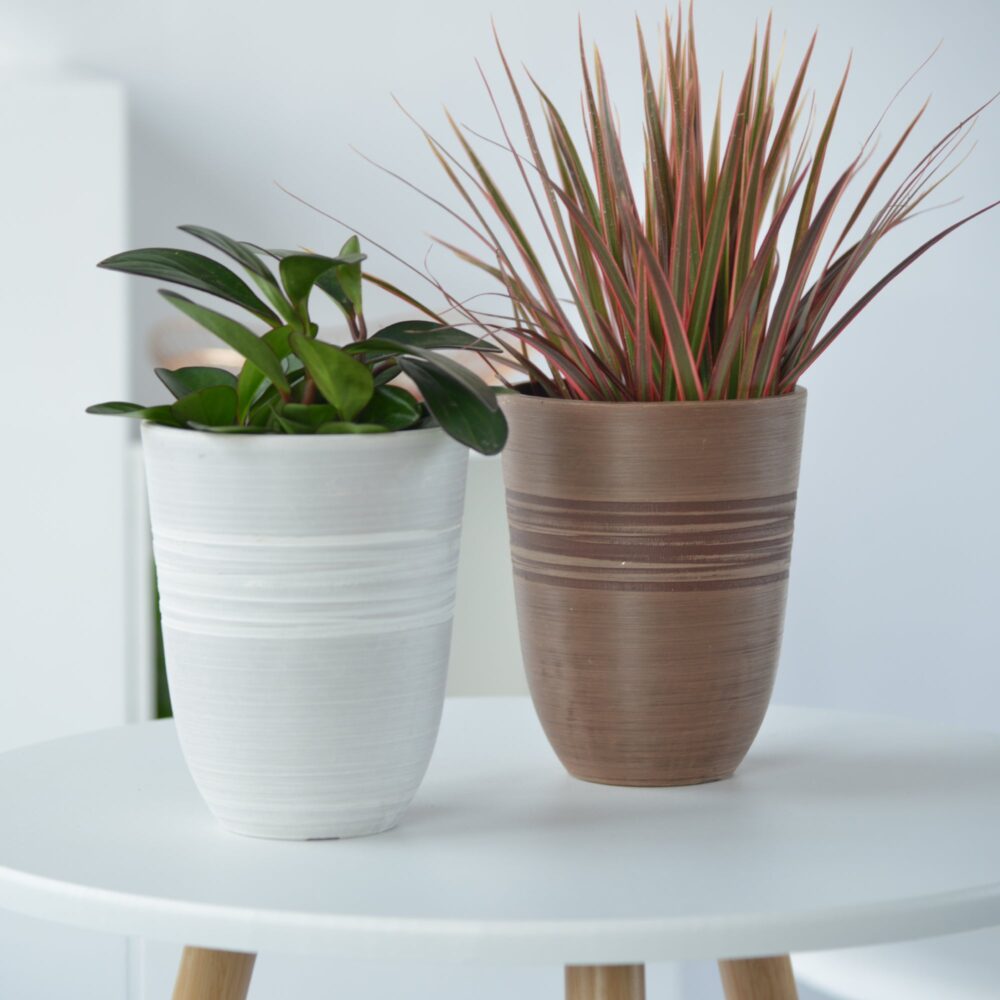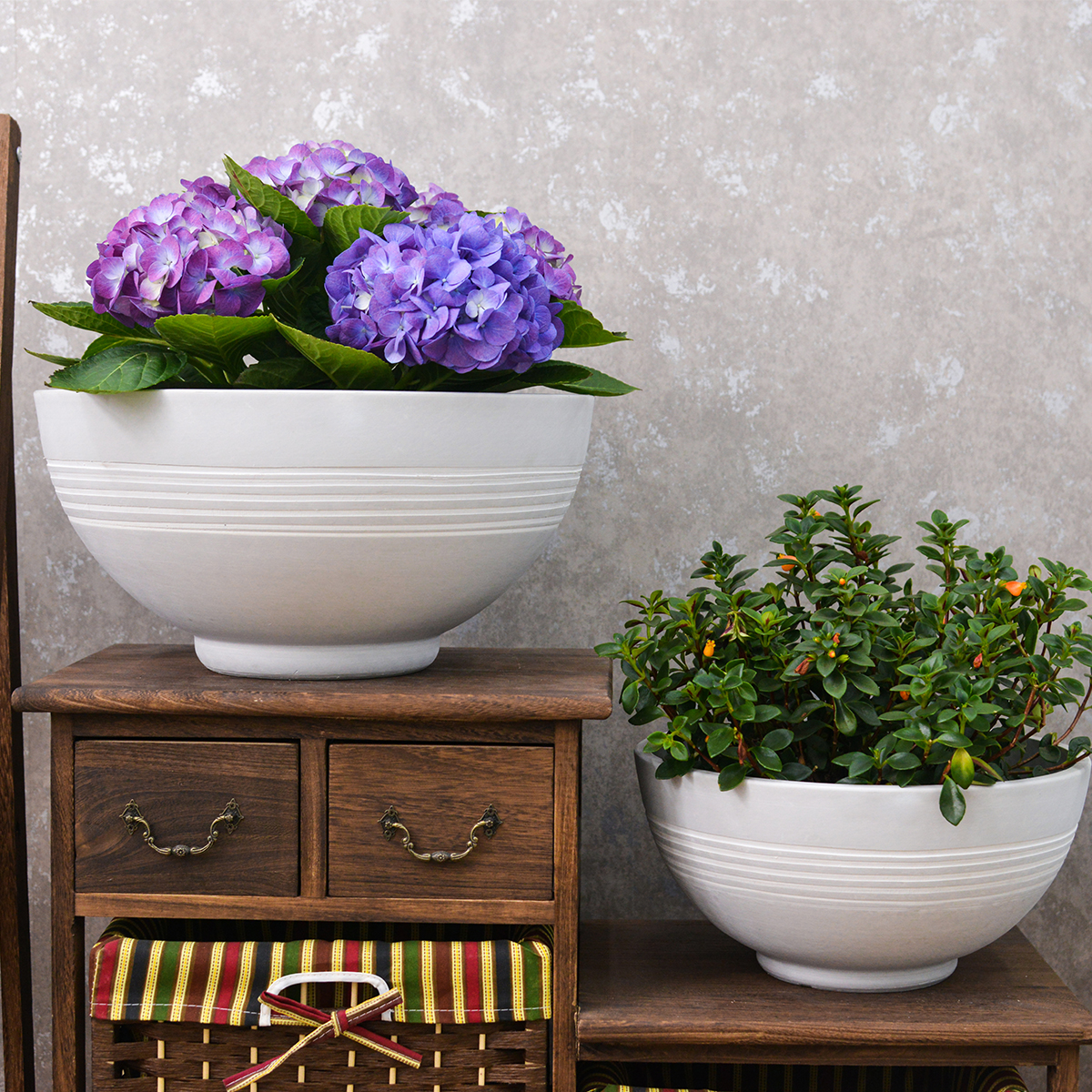Helichrysum in Pots: The Complete Guide to Growing Strawflowers Outdoors in Containers
Want to add vibrant, everlasting color and unique papery texture to your sunny patio, balcony, or garden? , commonly known as Strawflower or Everlasting Flower, are wonderfully cheerful and rewarding choices for outdoor container gardening, especially in sunny locations. Celebrated for their brightly colored, papery bracts that resemble petals, their wide array of warm colors from yellows and oranges to reds, pinks, purples, and whites, their exceptionally long blooming season, and their upright, bushy habit, Strawflowers are perfect for adding a touch of sunshine and enduring beauty to sunny outdoor spaces. This comprehensive guide will provide you with everything you need to know to grow Helichrysum bracteatum successfully in outdoor pots, from selecting the best varieties and containers to mastering essential care techniques for a season filled with Strawflower blooms and everlasting charm.

Strawflower
What are Helichrysum (Strawflowers)?
Helichrysum bracteatum, commonly called Strawflower or Everlasting Flower, is an annual flowering plant in the Asteraceae family (daisy family). Native to Australia, Helichrysum bracteatum are popular annuals grown for their brightly colored, papery bracts and everlasting blooms. Strawflower “petals” are actually modified leaves called bracts, which are stiff, papery, and retain their color and shape long after the flower is cut and dried, hence the common name “Everlasting Flower”. They come in a dazzling array of warm colors, including yellow, gold, orange, bronze, red, crimson, rose, pink, purple, lavender, and white, often with a contrasting dark center cone. Helichrysum bracteatumplants are characterized by their upright, bushy growth habit, lance-shaped, slightly rough leaves, and sturdy stems. They exhibit an upright, bushy, or slightly branching growth habit, typically reaching 1-3 feet in height and spreading 1-2 feet wide, depending on the cultivar and series. They are known for their brightly colored, papery bracts, wide color range, exceptionally long blooming season (summer to frost), sun-loving nature, and ease of drying, making them an invaluable addition to gardens and containers, especially for adding vibrant, long-lasting color and unique texture.
Are Helichrysum Good for Outdoor Pots?
Yes, Helichrysum bracteatum are exceptionally well-suited for outdoor pots and container gardening, and are in fact very commonly grown in containers, especially for sunny patios, balconies, and decks. Their upright, bushy growth habit, exceptionally long blooming season, tolerance of full sun and heat, and brightly colored, papery blooms make them ideal for filling pots, patio containers, window boxes, and mixed container arrangements for sunny locations. Strawflowers thrive in full sun and bloom profusely from summer until frost, providing an incredibly long-lasting and cheerful display in containers. Their relatively easy-care nature and continuous, self-cleaning blooms make them a fantastic and rewarding choice for container gardens of all styles, especially for creating bold, sunny displays, adding vertical interest, or for cut flower gardens on patios and balconies. Growing Strawflowers in pots also allows you to easily move them to optimal locations to enjoy their beauty, to follow the sun, and to control their growing conditions, especially soil drainage which they appreciate.
Ideal Growing Conditions for Helichrysum in Pots:
Types of Helichrysum for Pots: Many Helichrysum bracteatum varieties and series are excellent for pots, but consider your desired height, flower color, size, and growth habit when choosing:
- Dwarf Strawflowers: (Under 1.5 feet tall) – Compact and smaller in stature, ideal for small to medium pots, window boxes, edging, and foreground plantings. Known for their more compact habit and profusion of blooms on shorter stems. Excellent for smaller containers and tighter spaces. Look for series and cultivars like ‘ Dwarf Fairy Series’, ‘ Kidd Series’, ‘ Monstrosum Dwarf Mix’, ‘ Tom Thumb Mix’, and dwarf selections within larger series.
- Medium-Sized Strawflowers: (1.5-2.5 feet tall) – Bushy and more upright than dwarf types, but still relatively compact, suitable for medium to large pots, patio containers, and mixed arrangements. Offer larger flower heads and a wider range of colors in a manageable size for pots. Look for series like ‘ ColorPower Series’, ‘ Dreameria Series’, ‘ Granvia Series’ (medium types within series), ‘ Helios Series’, ‘ Apricot Mix’, ‘ Salmon Rose’, ‘ Bright Rose’, and many bracteatum hybrids. These are versatile for pots.
- Taller Strawflowers: (Over 2.5 feet tall) – More upright and taller, best suited for larger pots, as thrillers in mixed containers, and for back-of-border placements in large containers. Offer a more dramatic vertical presence and larger flower heads in containers, and are excellent for cut flowers. Look for taller series and cultivars like ‘ Tall Double Mix’, ‘ Fantastic Mix’, ‘ Giant Double Mix’, ‘ Strawburst Mix’, ‘ King Size Mix’, ‘ Purple Red’, ‘ Copper Red’, and taller selections within mixed series. Taller types may need staking in pots, especially in windy locations or if blooms are harvested for drying. For most container gardening, dwarf to medium types are more practical and easier to manage.
- Flower Size & Form (for Pots): Choose varieties based on your desired flower size and form. Strawflowers come in single, semi-double, and fully double forms, and various sizes.
- Small to Medium Flowers: (2-3 inches wide) – Most common flower size, abundant blooms, good for general pot display. ‘ Dwarf Fairy Series’, ‘ Kidd Series’, ‘ Monstrosum Dwarf Mix’, ‘ Tom Thumb Mix’, ‘ ColorPower Series’, ‘ Dreameria Series’, ‘ Helios Series’, ‘ Apricot Mix’, ‘ Salmon Rose’, ‘ Bright Rose’.
- Large Flowers: (3-4 inches wide or more) – Showier, more dramatic blooms, excellent for cut flowers and focal points in pots. ‘ Granvia Series’, ‘ Tall Double Mix’, ‘ Fantastic Mix’, ‘ Giant Double Mix’, ‘ Strawburst Mix’, ‘ King Size Mix’, ‘ Purple Red’, ‘ Copper Red’.
- Double Flowers: Fully double blooms have many layers of bracts, creating a fuller, more ruffled appearance. ‘ Tall Double Mix’, ‘ Giant Double Mix’, ‘ Dreameria Series’, ‘ Granvia Series’, ‘ Monstrosum Dwarf Mix’, ‘ Kidd Series’.
- Single Flowers: Single blooms have fewer bracts and a more open, daisy-like appearance, often with a more prominent central cone. ‘ Helios Series’, ‘ ColorPower Series’, ‘ Dwarf Fairy Series’, ‘ Tom Thumb Mix’.
- Color Themes (for Pots): Choose varieties based on your desired color palette for your sunny container garden. Strawflowers offer a wide range of warm colors.
- Yellows & Golds: ‘ Helios Yellow’, ‘ Granvia Gold’, ‘ Apricot Mix’, ‘ Golden Yellow’, ‘ Yellow King’, ‘ Goldfields’.
- Oranges & Bronze: ‘ Helios Orange’, ‘ Granvia Orange’, ‘ Bronze Shades’, ‘ Copper Red’, ‘ Orange King’, ‘ Sunset Orange’.
- Reds & Crimson: ‘ ColorPower Red’, ‘ Dreameria Red’, ‘ Purple Red’, ‘ Crimson King’, ‘ Scarlet Red’.
- Pinks & Roses: ‘ Dreameria Pink’, ‘ Salmon Rose’, ‘ Bright Rose’, ‘ Rose King’, ‘ Pink Sunrise’.
- Purples & Lavender: ‘ Dreameria Purple’, ‘ Purple Red’, ‘ Lavender Shades’, ‘ Violet King’, ‘ Purple Haze’.
- Whites & Creams: ‘ Helios White’, ‘ Granvia White’, ‘ White King’, ‘ Snowball’, ‘ Cream White’.
- Mixes: Many Strawflower series are available in mixed color packs, offering a vibrant blend of warm tones. ‘ Tall Double Mix’, ‘ Fantastic Mix’, ‘ Giant Double Mix’, ‘ Strawburst Mix’, ‘ King Size Mix’, ‘ Monstrosum Dwarf Mix’, ‘ Tom Thumb Mix’, ‘ ColorPower Mix’, ‘ Dreameria Mix’, ‘ Helios Mix’.
Light: Helichrysum thrive in full sun. They need at least 6-8 hours of direct sunlight per day to bloom profusely and develop their best, most vibrant colors. Choose a sunny location for your Strawflower containers, such as a south-facing patio, balcony, or garden bed. In partial shade, Strawflowers will produce fewer blooms, become leggy, and their flower colors may be less intense. Full sun is essential for optimal flowering, vibrant colors, and compact, floriferous growth.
Soil: Helichrysum need well-draining soil that is moderately fertile and slightly acidic to neutral. They are tolerant of somewhat poor, sandy, or gravelly soils, as long as drainage is excellent. Use a high-quality potting mixspecifically formulated for containers or flowers. Amend potting mix with perlite, vermiculite, or horticultural gritto improve drainage and aeration, which is crucial for Strawflowers, especially in pots. Avoid heavy, compacted soil or garden soil in pots, as they can become waterlogged. A slightly acidic to neutral pH (around 6.0-7.0) is ideal for Helichrysum.
Watering: Helichrysum are moderately drought-tolerant once established, but they perform best with consistent moisture, especially when young and when grown in pots. Water thoroughly when the top inch of soil feels slightly dry. Water deeply until water drains out of the drainage holes. Allow the soil surface to dry out slightly between waterings, but do not let the soil dry out completely for extended periods, especially during hot weather or when plants are in full bloom. Avoid overwatering and constantly soggy soil, which can lead to root rot. Strawflowers prefer a “moist but not soggy” soil environment. Watering frequency will depend on weather conditions, light levels, pot size, and plant size. During hot summer months, you may need to water daily or even twice a day for hanging baskets and smaller pots in full sun or windy locations. Check soil moisture regularly and adjust watering accordingly. Water at the base of the plant or use overhead watering early in the day to allow foliage to dry before evening, which can help prevent fungal diseases.
Temperature: Helichrysum are warm-weather annuals that thrive in warm temperatures. They perform best in temperatures between 65°F to 90°F (18°C to 32°C). They are heat-tolerant and bloom exceptionally well through hot summers, thriving in sunny, hot conditions. Strawflowers are frost-tender and are not cold-hardy. They are typically grown as annuals in most climates (USDA zones below 9). In USDA zones 9-11, Helichrysum may behave as short-lived perennials in very mild, frost-free areas, but are generally grown as annuals for best, most reliable performance and consistent blooms. Potted Strawflowers are easy to move to optimal locations to enjoy their beauty and follow the sun. They do not tolerate frost or freezing temperatures.
Fertilizer: Helichrysum are light feeders and do not require heavy fertilization. In fact, over-fertilizing can lead to leggy growth and fewer blooms. Fertilize sparingly, if at all. If desired, you can apply a dilute balanced liquid fertilizer (e.g., 10-10-10 or 20-20-20) diluted to quarter or half strength, every 4-6 weeks during the growing season (summer). For containers, occasional light feeding (e.g., every 6 weeks) may be beneficial, especially if using a very well-draining potting mix. Alternatively, you can incorporate a small amount of slow-release granular fertilizerinto the potting mix at planting time. Avoid high-nitrogen fertilizers, which can promote leafy growth at the expense of blooms. In general, Strawflowers prefer slightly lean soil and do not need rich, heavy fertilization.
Choosing the Right Pots for Helichrysum:
Suitable Pot Types: Helichrysum are exceptionally versatile in pot types, thriving in terracotta pots, ceramic pots, plastic pots, resin pots, and even metal containers. Consider these factors when selecting pot types for Strawflowers:
- Terracotta Pots: Porous, allow excellent aeration and drainage, and aesthetically classic and warm-toned, complementing Strawflower’s sunny, natural charm. Terracotta is an excellent choice for Strawflowers as it provides the well-drained conditions they appreciate, and the warm tones enhance their colors. Terracotta pots also dry out more quickly, which can be beneficial for Strawflowers, helping to prevent overwatering.
- Ceramic Pots: Glazed ceramic pots are a good choice, available in many decorative styles, can add a decorative element to your container garden, and provide good drainage if drainage holes are adequate. Choose based on your desired aesthetic and drainage needs. Ensure good drainage. Choose colors and styles that enhance the bright, warm tones of Strawflower blooms.
- Plastic Pots: Lightweight, inexpensive, retain moisture well, and are available in various colors and styles. Good choice for Strawflowers, especially for larger pots that need to be moved, and for moisture retention in very sunny or windy locations where pots may dry out quickly. Choose good quality plastic pots with drainage holes. Plastic pots help retain moisture, which can be beneficial, especially in hot, sunny locations and for busy gardeners.
- Resin Pots: Lightweight, durable, available in various styles mimicking terracotta or ceramic, and offer a balance of drainage and moisture retention. A good alternative to heavy ceramic pots, and often more durable than terracotta or plastic. Resin pots also retain moisture well, similar to plastic.
- Metal Containers: Metal containers can also be used, providing a more modern or industrial look. Ensure good drainage and consider that metal pots can heat up more quickly in sun, which is generally not a problem for heat-loving Strawflowers. Metal containers can add a bold, contemporary touch to Strawflower displays.
Drainage: Excellent drainage is absolutely essential for Helichrysum to prevent root rot. They are highly susceptible to root rot in soggy conditions. Ensure your chosen pot has drainage holes at the bottom. Avoid pots without drainage holes. Adding a generous layer of perlite or pot shards at the base of the pot is highly recommended to further improve drainage, especially in heavier pots or if you tend to overwater. Elevating pots slightly on pot feet or bricks can further improve drainage and air circulation around the base.
Pot Size: Choose pot sizes appropriate for the mature size and growth habit (dwarf vs. medium vs. tall) of the Strawflower you are planting, and the desired visual impact. Strawflowers have moderately sized root systems, but their upright, bushy growth benefits from adequate root space and stability, especially taller varieties.
- Small Pots (Dwarf Strawflowers, Individual Plants): For dwarf Strawflower varieties or individual plants in small pots, use pots that are at least 6-8 inches in diameter and at least 6 inches deep. These are suitable for very dwarf varieties or for starting individual plants.
- Medium Pots (Medium-Sized Strawflowers, Patio Containers, Combinations): For medium-sized Strawflower varieties, patio containers, or mixed arrangements, use pots that are 10-14 inches in diameter or larger and at least 8-10 inches deep for individual plants, or larger patio containers for multiple plants or mixed arrangements.
- Large Pots (Taller Strawflowers, Dramatic Displays, Cut Flower Gardens): For taller Strawflower varieties or more dramatic displays, use pots that are 12-16 inches in diameter or larger and at least 10-12 inches deepto accommodate their larger root systems and top growth, and provide stability for taller plants, especially if harvesting for cut flowers.
Color and Style: Choose pot colors and styles that complement your Strawflower blooms and your outdoor décor, and enhance their bright, cheerful, and sunny nature. Brightly colored pots in yellows, oranges, reds, blues, greens, or contrasting colors can enhance the vibrant colors of Strawflower bracts and create a bold, energetic display. Terra cotta or natural-look pots can provide a more earthy, garden-style feel, contrasting nicely with the bright, papery blooms. Simple, classic, or even slightly rustic pot styles often best showcase the natural, sunny charm of Strawflowers. Consider the overall style of your patio or garden and choose pots that harmonize with the surroundings, and enhance the bright, sunny, and cheerful ambiance you wish to create.
Essential Care Tips for Thriving Helichrysum in Outdoor Pots:
- Watering: “Water When Top Inch of Soil is Slightly Dry, Allow Surface to Dry Between Waterings, Avoid Soggy Soil”. Water thoroughly and regularly to maintain consistently moist soil, especially when young and during active blooming. Water deeply when the top inch of soil feels slightly dry. Allow the soil surface to dry slightly between waterings. Avoid overwatering and constantly soggy soil. Consistent moisture is key, but drainage is equally important.
- Sunlight: Provide Full Sun (6-8+ Hours Daily). Place Strawflower pots in a location that receives full sun for optimal growth, blooming, and vibrant colors.
- Fertilizing: Fertilize Sparingly, If At All. Light Feeding Every 4-6 Weeks (Optional). Fertilize sparingly, if at all. If desired, use a dilute balanced liquid fertilizer every 4-6 weeks, or incorporate a small amount of slow-release fertilizer at planting time. Avoid over-fertilizing.
- Deadheading (Optional, for Tidiness and Continued Bloom): Deadheading spent flower heads is not strictly necessary for continued blooming, as Strawflowers are self-cleaning, but you can remove faded heads for a tidier appearance and to encourage more branching and potentially slightly extended bloom. Snip off faded flower heads at the base of the stem.
- Pinching (Encourage Bushier Growth, Optional): Pinch back young Strawflower seedlings when they are young to encourage bushier growth and more flower stems. Pinch off the tips of stems when plants are young to promote branching if desired. Pinching is optional, but can result in fuller, bushier plants with even more blooms.
- Staking (Taller Varieties, Optional): Taller Strawflower varieties may benefit from staking, especially in windy locations or if blooms are being harvested for drying. Use bamboo stakes, plant supports, or twine to support taller stems and prevent them from flopping over.
- Drying Flowers (for Everlasting Bouquets): Strawflowers are famous for drying beautifully and retaining their color indefinitely. To dry Strawflowers, cut stems when bracts are just starting to open fully, remove leaves, and hang upside down in a cool, dark, dry, well-ventilated place for several weeks until fully dry and papery.
- Pest and Disease Control: Helichrysum are generally relatively pest and disease-resistant, but monitor for occasional pests like aphids, spider mites, and thrips, especially in hot, dry conditions. Fungal diseases like powdery mildew and root rot can occur if air circulation is poor or soil is kept too soggy. Ensure good air circulation by spacing plants adequately, avoid overcrowding, provide excellent drainage, and avoid overwatering. Treat any pest or disease issues promptly with insecticidal soap, horticultural oil, neem oil, or appropriate fungicides if necessary.
Popular Helichrysum Cultivars for Pots (by Series/Color/Size/Flower Form):
- Granvia Series (Suntory): Large, fully double flowers, sturdy stems, vibrant colors, excellent for pots and cut flowers. ‘Granvia Gold’, ‘Granvia Orange’, ‘Granvia White’, and other Granvia colors.
- Dreameria Series (Selecta One): Medium-sized, fully double flowers, wide color range, floriferous, reliable for pots and combinations. ‘Dreameria Yellow’, ‘Dreameria Orange’, ‘Dreameria Red’, ‘Dreameria Pink’, ‘Dreameria Purple’, ‘Dreameria White’, and mixed Dreameria colors.
- ColorPower Series (Dümmen Orange): Medium-sized, single flowers, intense colors, early blooming, good for pots and mass plantings. ‘ColorPower Yellow’, ‘ColorPower Orange’, ‘ColorPower Red’, and other ColorPower colors.
- Helios Series (Benary): Medium-sized, single flowers, bright, sunny colors, early blooming, reliable and versatile for pots. ‘Helios Yellow’, ‘Helios Orange’, ‘Helios White’, and mixed Helios colors.
- Dwarf Fairy Series (Goldsmith Seeds): Dwarf, compact habit, small flowers, early blooming, ideal for small pots, edging, and window boxes. ‘Dwarf Fairy Mix’.
- Kidd Series (Benary): Dwarf, compact habit, double flowers, early blooming, good color range, excellent for small pots. ‘Kidd Orange’, ‘Kidd Yellow’, ‘Kidd Salmon’, ‘Kidd Rose’, and mixed Kidd colors.
- Tall Double Mix (Seed Variety): Tall, upright habit, large, fully double flowers, classic Strawflower mix, excellent for cut flowers and back of border in large pots. ‘Tall Double Mix’.
In Summary:
Growing Helichrysum bracteatum (Strawflowers) in outdoor pots is a wonderfully rewarding way to fill your sunny patios, balconies, and gardens with vibrant, everlasting color and unique papery texture from summer until frost. Their brightly colored bracts, wide color range, exceptionally long blooming season, and relatively easy care make them a perfect choice for container gardeners seeking long-lasting, cheerful, and low-maintenance plants for sunny locations. By providing full sun, well-draining potting mix in pots with excellent drainage, consistent moisture but avoiding soggy soil, sparing fertilization, and choosing pot sizes and styles that showcase their sunny beauty, you can easily cultivate thriving Strawflower plants in pots and enjoy their captivating, colorful displays for many months each year, and even bring their everlasting beauty indoors as dried flowers.

Strawflower
For more detailed botanical information and to explore the diverse world of Helichrysum bracteatum, you can visit the Wikipedia page on Helichrysum bracteatum.
Important Note: Helichrysum bracteatum plants are generally considered non-toxic to humans and pets, making them a safe and attractive choice for households with children and animals. The primary care benefits of Strawflowers in pots are their exceptionally long blooming season, cheerful and abundant papery blooms, wide and vibrant color range, heat and sun tolerance, self-cleaning nature, ease of drying, and relatively easy care, bringing enduring sunshine and delightful, everlasting beauty to your outdoor spaces for many months. With these simple care practices, you can enjoy a season filled with the abundant charm of Strawflowers in your outdoor containers.
Modern Plant Pots丨Planter for Indoor Plants,8 inch or 10 inch Plant Pots with Drainage Hole,Decorative Flower Pots
By greenship-seo|2025-04-10T08:32:55+00:00January 7, 2025|Categories: Hand-carving Series|Tags: Decorative Flower Pots, Self-Watering Pots|
KC3-14A
By greenship|2024-08-16T06:26:30+00:00August 16, 2024|Categories: Hand-carving Series|
Planter 6 in W / 8 in W / 12 in W Indoor or Outdoor Plants, Modern Decorative Plant Pots with Drainage Hole, Decorative Flower Pots
By greenship-seo|2025-02-06T13:43:53+00:00January 16, 2025|Categories: Hand-carving Series|Tags: Decorative Flower Pots|
Plant Pots 6 inch 8 inch 10 inch for Indoor Plants, Set of 3 Modern Decorative Planter ts with Drainage Hole, Decorative Flower Pots
By greenship-seo|2025-04-10T06:39:28+00:00January 14, 2025|Categories: Hand-carving Series|Tags: Decorative Flower Pots|
KC3-09k
By greenship|2024-08-16T06:24:36+00:00August 16, 2024|Categories: Hand-carving Series|
k2-21G
By greenship|2024-08-13T06:17:26+00:00August 13, 2024|Categories: Hand-carving Series|






